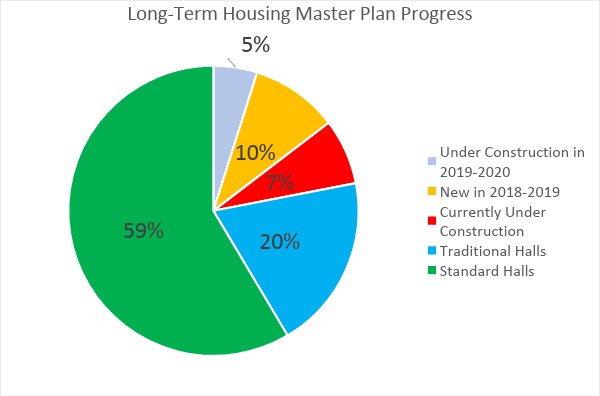Miami is more than halfway done with its long-term housing plan to upgrade the university’s 41 dormitories, a process that began in 2009 and is slated to end in 2028.
The first dorms to get revamped were Stoddard and Elliot halls. Three goals of the project have been moving common spaces out of basements, lightening the environmental impact and maintaining the character of the buildings. Newly remodeled halls feature more natural light in study rooms, central air conditioning and improved fire suppression systems.
“Many residence halls were well maintained over the years, but just old,” said Brian Woodruff, director of housing contracts and meal plans. “Before this plan, the average age of the residence halls was 65 years.”
A majority of the halls were built in the 1950s after World War II and there had been no significant renovations since. Miami began the renovation plans because it wanted to improve living amenities in order to compete with other universities, especially those in Ohio.
The campus-wide improvement is being done a few buildings at a time. Richard, Porter and MacCracken Halls are undergoing remodeling now and are scheduled to reopen in the fall of this year. Four brand new halls were also opened last fall.
“The idea is that we will have an ongoing routine of updating halls so that we don’t have to do another major project like this one,” said Woodruff.
Renovations funded through bonds
This extensive project has not been inexpensive. The remodeling of Porter Hall will cost $15 million, and the upcoming renovations of Stanton and Dodds are expected to be in a similar price range.

The planning stage began during the economic crisis of 2008. Once the dust settled, Miami saw its chance to build, as cheaper financing was available and construction costs were generally lower nationwide, said Robert Abowitz, assistant director of resident life.
“Residence halls are paid with auxiliary funds,” said Abowitz. “Much of the construction cost is funded through bonds. The university is actually incurring debt and is paying it off over the lifespan of the halls.”
On-campus housing rates range from $3,368 to $5,131 per semester, plus a standard residential fee of $400. There was a three percent increase in rates for all incoming students this year.
When determining the rate, Miami considers three factors: room occupancy, the type of hall, and the tuition guarantee. Based on whether a student lives in a single, double, triple, or quad room, the price varies.
All of the dorms are divided into one of two categories, either a traditional or standard hall. Traditional halls are dorms that haven’t been renovated or recently built, including such halls as Tappan, Peabody and Morris. Residence halls that have undergone recent remodeling are considered to be standard. When the remodeling plan is complete, every hall will be a standard hall.

Source: Campus Services Center
Another factor used to determine dorm rates is the tuition guarantee at Miami. Room and board falls under general tuition, which means that the rates will not change for students year-to-year.
“The actual price can change if someone moves from a double in a traditional hall to a single in a standard hall, but they’ll be paying the same rate for that room as the year before,” said Woodruff.
Increasing the appeal of the dorms also helps admissions. Students are more inclined to pick the remodeled standard dorms than the old traditional hall. Sophomore Mychael Dopirak, who lives in a double room in Flower Hall, said the standard dorms are worth a slight inconvenience.
“I chose Flower because it was one of the newer dorms on campus,” Dopirak said. “I knew it was a little farther away, but it’s worth it to live in a nicer hall. I spent a lot of time in Stanton during my freshman year and it was noticeably dated. The rooms were small, walls were thin, and the bathrooms were gross.”
In 2028, the process will repeat
Peabody Hall is expected to be the final dorm to be remodeled in 2028, just in time for the university to restart the process, but on a smaller scale.
“Ideally when we finish in 2028, we’ll restart the process and just add necessary updates,” said Robert Bell, associated director of campus planning. “We’ve learned something new on each project. We’re more efficient with our time and money now.”








